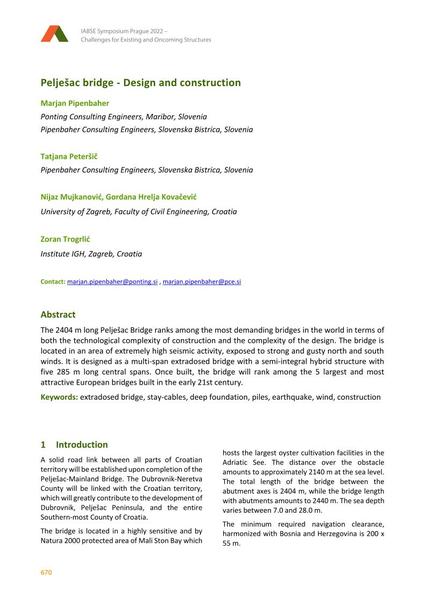Pelješac bridge - Design and construction

|
|
|||||||||||
Bibliografische Angaben
| Autor(en): |
Marjan Pipenbaher
(Ponting Consulting Engineers, Maribor, Slovenia; Pipenbaher Consulting Engineers, Slovenska Bistrica, Slovenia)
Tatjana Peteršič (Pipenbaher Consulting Engineers, Slovenska Bistrica, Slovenia) Nijaz Mujkanović (University of Zagreb, Faculty of Civil Engineering, Croatia) Gordana Hrelja Kovačević (University of Zagreb, Faculty of Civil Engineering, Croatia) Zoran Trogrlić (Institute IGH, Zagreb, Croatia) |
||||
|---|---|---|---|---|---|
| Medium: | Tagungsbeitrag | ||||
| Sprache(n): | Englisch | ||||
| Tagung: | IABSE Symposium: Challenges for Existing and Oncoming Structures, Prague, Czech Republic, 25-27 May 2022 | ||||
| Veröffentlicht in: | IABSE Symposium Prague 2022 | ||||
|
|||||
| Seite(n): | 670-677 | ||||
| Anzahl der Seiten (im PDF): | 8 | ||||
| DOI: | 10.2749/prague.2022.0670 | ||||
| Abstrakt: |
The 2404 m long Pelješac Bridge ranks among the most demanding bridges in the world in terms of both the technological complexity of construction and the complexity of the design. The bridge is located in an area of extremely high seismic activity, exposed to strong and gusty north and south winds. It is designed as a multi-span extradosed bridge with a semi-integral hybrid structure with five 285 m long central spans. Once built, the bridge will rank among the 5 largest and most attractive European bridges built in the early 21st century. |
||||
| Stichwörter: |
Wind Erdbeben Extradosed-Brücke Tiefgründung
|
||||
| Copyright: | © 2022 International Association for Bridge and Structural Engineering (IABSE) | ||||
| Lizenz: | Die Urheberrechte (Copyright) für dieses Werk sind rechtlich geschützt. Es darf nicht ohne die Zustimmung des Autors/der Autorin oder Rechteinhabers/-in weiter benutzt werden. |
||||
